National Assembly of the Republic of Serbia / Citizens' corner / Education center / Cultural heritage / Architecture
Architecture
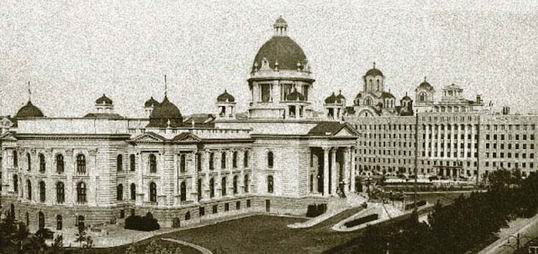
Historical view
The design for the building of the House of the National Assembly was made by the architect Konstantin A. Jovanovic, who lived and worked in Vienna. The representative parliamentary edifice was designed by Jovanovic in the manner of academic architecture of monumental public buildings. Unfortunately, the Serbian state did not have the financial resources for this kind of project.
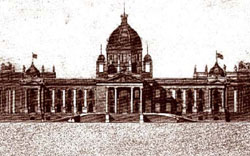
Façade project
This competition did not pass without public criticism. It was considered that the winning design was too similar to Jovanovic's design and could therefore not be considered an original creation. It was also noted that it had too little of its own architectural tradition. The public requested that a new competition be held which would set a requirement of designing the parliamentary edifice in the national style.
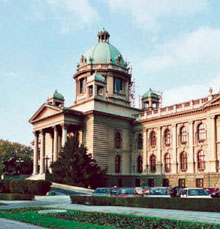
Main façade
King Peter I laid the cornerstone for the new House of National Representation on August 27, 1907, in the presence of many distinguished guests.
Due to a lack of resources, as well as to the Balkan and First World Wars, by the beginning of the establishment of the new state-the Kingdom of Serbs, Croats and Slovenes- the parliamentary edifice was constructed only up to the first floor.
Since the new, much bigger state was established, the planned parliamentary session halls did not provide sufficient space and their reconstruction was necessary. In 1920, along with the decision to continue construction works on the Assembly, the decision was brought to entrust the design to the architect Pavle Ilkic, son and associate of Jovan Ilkic who died in a prisoner of war camp in 1917.
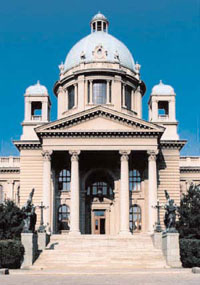
Main entrance
The Architectural Department of the Ministry of Construction assumed the responsibility for all the work and the chief architect was Nikola Krasnov, a Russian immigrant close to the court. At the time, he was the author of some of the most significant edifices in the capital.
The building of the National Assembly was finally constructed and consecrated on October 18, 1936, almost three decades after having laid the cornerstone.
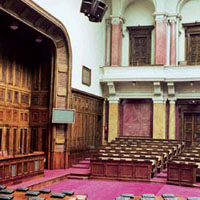
Large plenary hall
The subterranean part is constructed rustically in the green stone of Ripanj and the high ground floor and the upper floor, embellished only by a row of windows and pilasters, end with the roof cornice and the balustrade above it. All facades are covered by artificial stone.
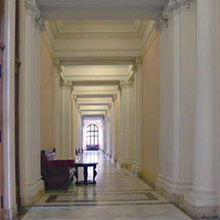
Hallway in the basement
The monumental stairway leads to the vestibule - the entrance hall. A long corridor separates the vestibule from the central hall, staircase, and the small and big session halls. Along the corridor, parallel to the vestibule, there are offices.
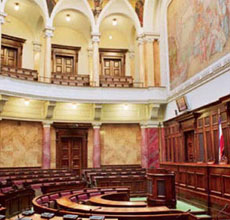
Small plenary hall
The entire design of the interior, including all the details, was made by the architect Nikola
Krasnov.
The vestibule stands out because of its significance, its successful combination of architecture, sculpture, handiwork, and richness of applied material. The representative marble floor, polychromous plaster decoration of the walls, marble pillars, first floor loggias, rich decoration of the dome drums and zenithal lightening create a magnificent framework for the four standing marble sculptures of the rulers placed in the niches.
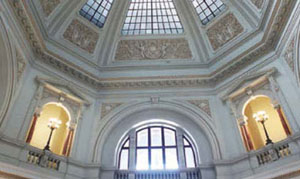
Dome over entrance hall
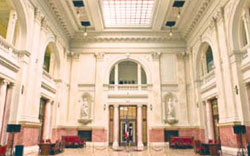
Hall
The representative offices with a view on Kosovska Street and King Aleksandar Boulevard differ from other offices by the way in which the walls and floors were finalized.
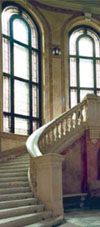
The walls are covered by oak and walnut woodwork and the floors are covered by intarsia parquets. The furniture is especially designed for these rooms.
The specific characteristics of the ground floor halls, left and right from the central hall, are the leaning massive pillars with the Corinthian capitals, plaster decoration of the ceiling, and especially wrought engraved door.The interior of the library is carefully designed and the furniture is shaped in a national style.
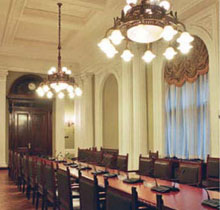
Room in basement
For its important function- the connection with the historical events and architectural and artistic values- the building of the Assembly was proclaimed a cultural monument in 1984.
-
11.00 - Sitting of the Subcommittee for Monitoring the Agricultural Situation in Marginal Areas with Difficult Working Conditions in the Republic of Serbia (National Assembly House, 13 Nikola Pasic Square, hall 3)
-
12.30 - the Head of the ALEKSANDAR VUCIC – Serbia Must Not Stop Parliamentary Group Milenko Jovanov meets with UK Embassy representatives (National Assembly House, 13 Nikola Pasic Square, hall 2)

